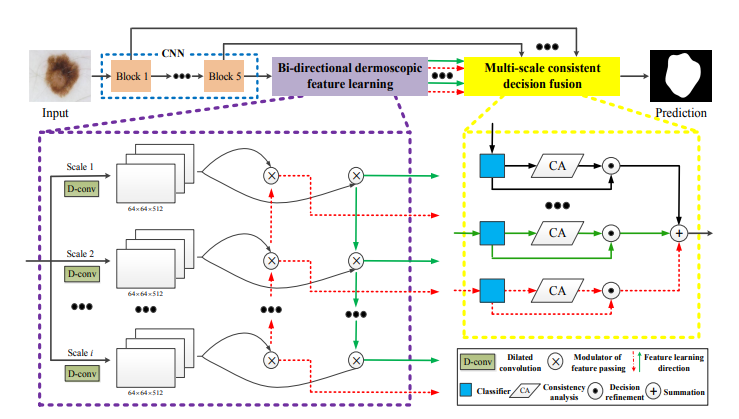- ALL COMPUTER, ELECTRONICS AND MECHANICAL COURSES AVAILABLE…. PROJECT GUIDANCE SINCE 2004. FOR FURTHER DETAILS CALL 9443117328


Projects > ELECTRONICS > 2020 > IEEE > DIGITAL IMAGE PROCESSING
Accurate segmentation of skin lesion from dermoscopic images is a crucial part of computer-aided diagnosis of melanoma. It is challenging due to the fact that dermoscopic images from different patients have non-negligible lesion variation, which causes difficulties in anatomical structure learning and consistent skin lesion delineation. In this paper, we propose a novel bi-directional dermoscopic feature learning (biDFL) framework to model the complex correlation between skin lesions and their informative context. By controlling feature information passing through two complementary directions, a substantially rich and discriminative feature representation is achieved. Specifically, we place biDFL module on the top of a CNN network to enhance high-level parsing performance. Furthermore, we propose a multi-scale consistent decision fusion (mCDF) that is capable of selectively focusing on the informative decisions generated from multiple classification layers. By analysis of the consistency of the decision at each position, mCDF automatically adjusts the reliability of decisions and thus allows a more insightful skin lesion delineation.
Fully convolutional neural networks (FCNs)
We propose a multi-scale consistent decision fusion (mCDF) that assesses the reliability of each decision in score maps generated from multiple classification layers. Our multi-scale consistent decision fusion embeds the consistency information around local decision context to adjust the confidence of decision and thus allows more reliable and precise skin lesion delineation. If the decision for a candidate pixel is consistent to its local context decision, then the network gives high confidence for this decision; otherwise the network reduces the confidence of this decision. Our segmentation network is fully convolutional that provides an end-to-end way for skin lesion training and prediction. Main contributions of this paper are summarized as follows: We propose a bi-directional dermoscopic feature learning framework to generate a substantially rich and discriminative feature representation by integrating skin lesions with their informative context. By manipulating the feature propagation through two complementary directions among high-level layers, we improve the image parsing ability of the network. We further propose a multi-scale consistent decision fusion to enhance the reliability and consistency of the decision by selectively fusing decisions generated from multiple classification layers
BLOCK DIAGRAM
